SNP Loci and Favorable Haplotype Mining for Alkalinity Tolerance in the Rice Bud Stage
Abstract
:1. Introduction
2. Materials and Methods
2.1. Plant Materials and Field Planting
2.2. Identification of Alkalinity Resistance
2.3. SNP Genotyping
2.4. Genome-Wide Association Analysis
2.5. Transcriptome Analysis
2.6. Candidate Gene Prediction and Haplotype Analysis
3. Results
3.1. Identification of Alkalinity-Tolerant Phenotypes of Rice at the Bud Stage
3.2. Genome-Wide Association Analysis
3.3. Transcriptome Sequencing Analysis of Rice with Tolerance to Alkaline Conditions
3.4. Analysis of Alkalinity-Tolerant Candidate Genes
3.5. Haplotype Analysis of Candidate Genes
4. Discussion
5. Conclusions
Supplementary Materials
Author Contributions
Funding
Data Availability Statement
Acknowledgments
Conflicts of Interest
References
- Li, N.; Zheng, H.; Cui, J.; Wang, J.; Liu, H.; Sun, J.; Liu, T.; Zhao, H.; Lai, Y.; Zou, D. Genome-wide association study and candidate gene analysis of alkalinity tolerance in japonica rice germplasm at the seedling stage. Rice 2019, 12, 24. [Google Scholar] [CrossRef] [PubMed]
- Ma, X.; Feng, F.; Wei, H.; Mei, H.; Xu, K.; Chen, S.; Li, T.; Liang, X.; Liu, H.; Luo, L. Genome-wide association study for plant height and grain yield in rice under contrasting moisture regimes. Front. Plant Sci. 2016, 7, 1801. [Google Scholar] [CrossRef] [PubMed]
- Nam, M.; Bang, E.; Kwon, T.; Kim, Y.; Kim, E.; Cho, K.; Park, W.; Kim, B.-G.; Yoon, I. Metabolite profiling of diverse rice germplasm and identification of conserved metabolic markers of rice roots in response to long-term mild salinity stress. Int. J. Mol. Sci. 2015, 16, 21959–21974. [Google Scholar] [CrossRef] [PubMed]
- Chen, W.; Cui, P.; Sun, H.; Guo, W.; Yang, C.; Jin, H.; Fang, B.; Shi, D. Comparative effects of salt and alkali stresses on organic acid accumulation and ionic balance of seabuckthorn (Hippophae rhamnoides L.). Ind. Crops Prod. 2009, 30, 351–358. [Google Scholar] [CrossRef]
- Ganapati, R.K.; Naveed, S.A.; Zafar, S.; Wang, W.; Xu, J. Saline-alkali tolerance in rice: Physiological response, molecular mechanism, and QTL identification and application to breeding. Rice Sci. 2022, 29, 412–434. [Google Scholar] [CrossRef]
- Ma, C.; Ma, L.; Liu, T.; Zou, H.; Zhang, B.; Liu, Y. Research progress on saline land improvement technology. World For. Res. 2010, 23, 28–32. [Google Scholar]
- Ye, X.; Wang, H.; Cao, X.; Jin, X.; Cui, F.; Bu, Y.; Liu, H.; Wu, W.; Takano, T.; Liu, S. Transcriptome profiling of Puccinellia tenuiflora during seed germination under a long-term saline-alkali stress. BMC Genom. 2019, 20, 589. [Google Scholar] [CrossRef]
- De Pascale, S.; Maggio, A.; Barbieri, G. Soil salinization affects growth, yield and mineral composition of cauliflower and broccoli. Eur. J. Agron. 2005, 23, 254–264. [Google Scholar] [CrossRef]
- Qadir, M.; Noble, A.D.; Schubert, S.; Thomas, R.J.; Arslan, A. Sodicity-induced land degradation and its sustainable management: Problems and prospects. Land Degrad. Dev. 2006, 17, 661–676. [Google Scholar] [CrossRef]
- Zhang, J.-T.; Mu, C.-S. Effects of saline and alkaline stresses on the germination, growth, photosynthesis, ionic balance and anti-oxidant system in an alkali-tolerant leguminous forage Lathyrus quinquenervius. Soil Sci. Plant Nutr. 2009, 55, 685–697. [Google Scholar] [CrossRef]
- Roy, S.J.; Tucker, E.J.; Tester, M. Genetic analysis of abiotic stress tolerance in crops. Curr. Opin. Plant Biol. 2011, 14, 232–239. [Google Scholar] [CrossRef] [PubMed]
- Zhang, G.; Bi, Z.; Jiang, J.; Lu, J.; Li, K.; Bai, D.; Wang, X.; Zhao, X.; Li, M.; Zhao, X.; et al. Genome-wide association and epistasis studies reveal the genetic basis of saline-alkali tolerance at the germination stage in rice. Front. Plant Sci. 2023, 14, 1170641. [Google Scholar] [CrossRef] [PubMed]
- Wang, W.L. Using Indica-Japonica Cross RIL Population to Locate QTLs Related to Salt and Alkali Tolerance in Rice; Shenyang Agricultural University: Shenyang, China, 2020. [Google Scholar]
- Liang, Y.; Sun, J.; Suo, Y.; Liu, H.; Wang, J.; Zheng, H.; Sun, X.; Zou, D. QTL Mapping and QTL × Environment Interaction Analysis of Salt and Alkali Tolerance-Related Traits in Rice (Oryza sativa L.). Chin. J. Agric. Sci. 2017, 50, 1747–1762. [Google Scholar]
- Wu, Q.; Zhang, C.W.; Li, S.S.; Zheng, H.L. QTL Analysis of Salt and Alkali Tolerance at Bud Stage in Rice. Heilongjiang Agric. Sci. 2021, 2, 6–12. [Google Scholar]
- Wang, X.Y. QTL Mapping and Physiological Function Analysis of Salt and Alkali Tolerance in Rice at Bud and Seedling Stage; Shenyang Agricultural University: Shenyang, China, 2019. [Google Scholar]
- Li, X.; Zheng, H.; Wu, W.; Liu, H.; Wang, J.; Jia, Y.; Li, J.; Yang, L.; Lei, L.; Zou, D.; et al. QTL mapping and candidate gene analysis for alkali tolerance in japonica rice at the bud stage based on linkage mapping and genome-wide association study. Rice 2020, 13, 48. [Google Scholar] [CrossRef]
- Cui, J.N. Genome Wide Association Analysis of SaltTolerance and Alkali Tolerance in Japonica Rice Seedlings; The Northeast Agricultural University: Harbin, China, 2020. [Google Scholar]
- Li, N. Genome-Wide Association Study and Candidate Gene Mining of Alkaline Tolerance in Japonica Rice at the Seedling Stage; The Northeast Agricultural University: Harbin, China, 2019. [Google Scholar]
- Guan, Q.J.; Ma, H.Y.; Wang, Z.J.; Wang, Z.Y.; Bu, Q.Y.; Liu, S.K. A rice LSD1-like-type ZFP gene OsLOL5 enhances saline-alkaline tolerance in transgenic Arabidopsis thaliana, yeast and rice. BMC Genom. 2016, 17, 142. [Google Scholar] [CrossRef]
- Liu, Z.; Hu, Y.; Du, A.; Yu, L.; Fu, X.; Wu, C.; Lu, L.; Liu, Y.; Wang, S.; Huang, W.; et al. Cell wall matrix polysaccharides contribute to salt–alkali tolerance in rice. Int. J. Mol. Sci. 2022, 23, 15019. [Google Scholar] [CrossRef]
- Liu, X.; Yin, Z.; Wang, Y.; Cao, S.; Yao, W.; Liu, J.; Lu, X.; Wang, F.; Zhang, G.; Xiao, Y.; et al. Rice cellulose synthase-like protein OsCSLD4 coordinates the trade-off between plant growth and defense. Front. Plant Sci. 2022, 13, 980424. [Google Scholar] [CrossRef]
- Zhao, H.; Li, Z.; Wang, Y.; Wang, J.; Xiao, M.; Liu, H.; Quan, R.; Zhang, H.; Huang, R.; Zhu, L.; et al. Cellulose synthase-like protein OsCSLD4 plays an important role in the response of rice to salt stress by mediating abscisic acid biosynthesis to regulate osmotic stress tolerance. Plant Biotechnol. J. 2021, 20, 468–484. [Google Scholar] [CrossRef]
- Guo, M.; Wang, R.; Wang, J.; Hua, K.; Wang, Y.; Liu, X.; Yao, S. ALT1, a Snf2 family chromatin remodeling ATPase, negatively regulates alkaline tolerance through enhanced defense against oxidative stress in rice. PLoS ONE 2014, 9, e112515. [Google Scholar] [CrossRef]
- Guo, M.; Zhao, H.; He, Z.; Zhang, W.; She, Z.; Mohammadi, M.A.; Shi, C.; Yan, M.; Tian, D.; Qin, Y. Comparative Expression Profiling of Snf2 Family Genes During Reproductive Development and Stress Responses in Rice. Front. Plant Sci. 2022, 13, 910663. [Google Scholar] [CrossRef] [PubMed]
- Zhu, F.; Wang, K.; Li, D.; Liu, Z.; Li, M.; Wang, Z.; Li, X.; Lan, X.; Guan, Q. OsSAP6 positively regulates soda saline–alkaline stress tolerance in rice. Rice 2022, 15, 69. [Google Scholar] [CrossRef] [PubMed]
- Liu, Y.; Chen, X.; Xue, S.; Quan, T.; Cui, D.; Han, L.; Cong, W.; Li, M.; Yun, D.; Liu, B.; et al. Set domain group 721 protein functions in saline-alkaline stress tolerance in the model rice variety Kitaake. Plant Biotechnol. J. 2021, 19, 2576–2588. [Google Scholar] [CrossRef] [PubMed]
- Kobayashi, N.I.; Yamaji, N.; Yamamoto, H.; Okubo, K.; Ueno, H.; Costa, A.; Tanoi, K.; Matsumura, H.; Fujii-Kashino, M.; Horiuchi, T.; et al. OsHKT1;5 mediates Na(+) exclusion in the vasculature to protect leaf blades and reproductive tissues from salt toxicity in rice. Plant J. 2017, 91, 657–670. [Google Scholar] [CrossRef] [PubMed]
- Leng, C.; Zheng, F.; Zhao, B.; Liu, H.; Wang, Y. Advances on Alkaline Tolerance of Rice. Biotechnol. Bull. 2020, 4, 103–111. [Google Scholar] [CrossRef]
- Liang, W.; Ma, X.; Wan, P.; Liu, L. Plant salt-tolerance mechanism: A review. Biochem. Biophys. Res. Commun. 2018, 495, 286–291. [Google Scholar] [CrossRef]
- Li, F.L.; Luo, C.K.; Lu, X.P.; Tian, L.; Li, P.F. Current Status and Prospect of Research on Physiology and Genetic Mechanism of Alkali Tolerance in Rice. J. Plant Genet. Resour. 2021, 22, 83292. [Google Scholar] [CrossRef]
- Du, M.; Xiong, M.; Chang, Y.; Liu, Z.; Wang, R.; Lin, X.; Zhou, Z.; Lu, M.; Liu, C.; Liu, E. Mining candidate genes and favorable haplotypes for flag leaf shape in rice (Oryza sativa L.) based on a genome-wide association study. Agronomy 2022, 12, 1814. [Google Scholar] [CrossRef]
- Yu, J.; Pressoir, G.; Briggs, W.H.; Vroh Bi, I.; Yamasaki, M.; Doebley, J.F.; McMullen, M.D.; Gaut, B.S.; Nielsen, D.M.; Holland, J.B.; et al. A unified mixed-model method for association mapping that accounts for multiple levels of relatedness. Nat. Genet. 2006, 38, 203–208. [Google Scholar] [CrossRef]
- Zhao, K.; Aranzana, M.J.; Kim, S.; Lister, C.; Shindo, C.; Tang, C.; Toomajian, C.; Zheng, H.; Dean, C.; Marjoram, P.; et al. An arabidopsis example of association mapping in structured samples. PLoS Genet. 2007, 3, e4. [Google Scholar] [CrossRef]
- Zhao, H.X.; Xu, Z.J.; Huang, X.Q.; Chan, L.L.; Wang, C.; Li, M.; Zhang, Y.J. Analysis and Screening Evaluation Indexes for Alkaline Tolerance of Rice at Germination Period in Cold. Seed 2011, 30, 1–7+11. [Google Scholar]
- Xing, J.; Chang, H.L.; Wang, J.G.; Liu, H.L.; Sun, J.; Zheng, H.L.; Zhao, H.W.; Zou, D.T. QTL Analysis of Na+ and K+ Concentrations in Japonica Rice Under Salt and Alkaline Stress. Chin. J. Agric. Sci. 2015, 48, 604–612. [Google Scholar]
- Zou, D.T.; Ma, J.; Wang, J.G.; Liu, H.L.; Sun, J.; Wang, Z.X.; Huang, Y.Y.; Wu, Q.; Xing, W. QTL identification of alkaline tolerance at early seedling stage in japonica rice. J. Northeast Agric. Univ. 2013, 44, 12–18. [Google Scholar]
- Lin, H.X.; Zhu, M.Z.; Yano, M.; Gao, J.P.; Liang, Z.W.; Su, W.A.; Hu, X.H.; Ren, Z.H.; Chao, D.Y. QTLs for Na+ and K+ uptake of the shoots and roots controlling rice salt tolerance. Theor. Appl. Genet. 2004, 108, 253–260. [Google Scholar] [CrossRef] [PubMed]
- Li, N.; Sun, J.; Wang, J.; Liu, H.; Zheng, H.; Yang, L.; Liang, Y.; Li, X.; Zou, D. QTL analysis for alkaline tolerance of rice and verification of a major QTL. Plant Breed. 2017, 136, 881–891. [Google Scholar] [CrossRef]
- Liang, J.L.; Qu, Y.P.; Yang, C.G.; Ma, X.D.; Cao, G.L.; Zhao, Z.W.; Zhang, S.Y.; Zhang, T.; Han, L.Z. Identification of QTLs associated with salt or alkaline tolerance at the seedling stage in rice under salt or alkaline stress. Euphytica 2015, 201, 441–452. [Google Scholar] [CrossRef]
- Singh, L.; Coronejo, S.; Pruthi, R.; Chapagain, S.; Bhattarai, U.; Subudhi, P.K. Genetic dissection of alkalinity tolerance at the seedling stage in rice (Oryza sativa) using a high-resolution linkage map. Plants 2022, 11, 3347. [Google Scholar] [CrossRef]
- Qi, D.-l.; Lee, J.-r.; Yang, C.-g.; Lee, M.-c.; Cao, G.-l.; Zhang, J.-g.; Zhou, Q.-y.; Suh, S.-c. ZHANG San-yuan, HAN Long-zhi Detection of QTL for Alkali Tolerance at the Germination Stage in japonica Rice. J. China Rice Sci. 2009, 23, 589–594. [Google Scholar]
- Singh, L.; Coronejo, S.; Pruthi, R.; Chapagain, S.; Subudhi, P.K. Integration of QTL mapping and whole genome sequencing identifies candidate genes for alkalinity tolerance in rice (Oryza sativa). Int. J. Mol. Sci. 2022, 23, 11791. [Google Scholar] [CrossRef]
- Sabouri, H.; Rezai, A.M.; Moumeni, A.; Kavousi, A.; Katouzi, M.; Sabouri, A. QTLs mapping of physiological traits related to salt tolerance in young rice seedlings. Biol. Plant. 2009, 53, 657–662. [Google Scholar] [CrossRef]
- Jain, M.; Nijhawan, A.; Arora, R.; Agarwal, P.; Ray, S.; Sharma, P.; Kapoor, S.; Tyagi, A.; Khurana, J.P. F-box proteins in rice. Genome-wide analysis, classification, temporal and spatial gene expression during panicle and seed development, and regulation by light and abiotic stress. Plant Physiol. 2007, 143, 1467–1483. [Google Scholar] [CrossRef]
- Xu, G.; Cui, Y.; Wang, M.; Li, M.; Yin, X.; Xia, X. OsMsr9, a novel putative rice F-box containing protein, confers enhanced salt tolerance in transgenic rice and Arabidopsis. Mol. Breed. 2014, 34, 1055–1064. [Google Scholar] [CrossRef]
- Yan, Y.; Zhang, Y.; Yang, K.; Sun, Z.; Fu, Y.; Chen, X.; Fang, R. Small RNAs from MITE-Derived Stem-Loop Precursors Regulate Abscisic Acid Signaling and Abiotic Stress Responses in Rice. Plant J. 2011, 65, 820–828. [Google Scholar] [CrossRef]
- Yan, Y.-S.; Chen, X.-Y.; Yang, K.; Sun, Z.-X.; Fu, Y.-P.; Zhang, Y.-M.; Fang, R.-X. Overexpression of an F-box protein gene reduces abiotic stress tolerance and promotes root growth in rice. Mol. Plant 2011, 4, 190–197. [Google Scholar] [CrossRef]
- Fan, C.; Zhang, Y.; Yang, C.; Tang, Y.; Qu, J.I.; Jie, B.U.; Quzhen, D.; Gao, L. Overexpression of rice F-box phloem protein gene OsPP12-A13 confers salinity tolerance in Arabidopsis. Biocell 2021, 45, 1121–1135. [Google Scholar] [CrossRef]
- Jain, N.; Khurana, P.; Khurana, J.P. Overexpression of a rice tubby-like protein-encoding gene, OsFBT4, confers tolerance to abiotic stresses. Protoplasma 2023, 260, 1063–1079. [Google Scholar] [CrossRef] [PubMed]
- Xu, G.; Cui, Y.; Li, M.; Wang, M.; Yu, Y.; Zhang, B.; Huang, L.; Xia, X. OsMSR2, a novel rice calmodulin-like gene, confers enhanced salt tolerance in rice (Oryza sativa L.). Aust. J. Crop Sci. 2013, 7, 368–373. [Google Scholar]
- Xu, G.Y.; Rocha, P.S.; Wang, M.L.; Xu, M.L.; Cui, Y.C.; Li, L.Y.; Zhu, Y.X.; Xia, X. A novel rice calmodulin-like gene, OsMSR2, enhances drought and salt tolerance and increases ABA sensitivity in Arabidopsis. Planta 2011, 234, 47–59. [Google Scholar] [CrossRef] [PubMed]
- Phean-o-pas, S.; Limpaseni, T.; Buaboocha, T. Structure and expression analysis of the OsCam1-1 calmodulin gene from Oryza sativa L. BMB Rep. 2008, 41, 771–777. [Google Scholar] [CrossRef] [PubMed]
- Yuenyong, W.; Chinpongpanich, A.; Comai, L.; Chadchawan, S.; Buaboocha, T. Downstream components of the calmodulin signaling pathway in the rice salt stress response revealed by transcriptome profiling and target identification. BMC Plant Biol. 2018, 18, 335. [Google Scholar] [CrossRef] [PubMed]
- Sripinyowanich, S.; Klomsakul, P.; Boonburapong, B.; Bangyeekhun, T.; Asami, T.; Gu, H.; Buaboocha, T.; Chadchawan, S. Exogenous ABA induces salt tolerance in indica rice (Oryza sativa L.): The role of OsP5CS1 and OsP5CR gene expression during salt stress. Environ. Exp. Bot. 2013, 86, 94–105. [Google Scholar] [CrossRef]
- Yin, X.M.; Huang, L.F.; Zhang, X.; Wang, M.L.; Xu, G.Y.; Xia, X.J. OsCML4 improves drought tolerance through scavenging of reactive oxygen species in rice. J. Plant Biol. 2015, 58, 68–73. [Google Scholar] [CrossRef]
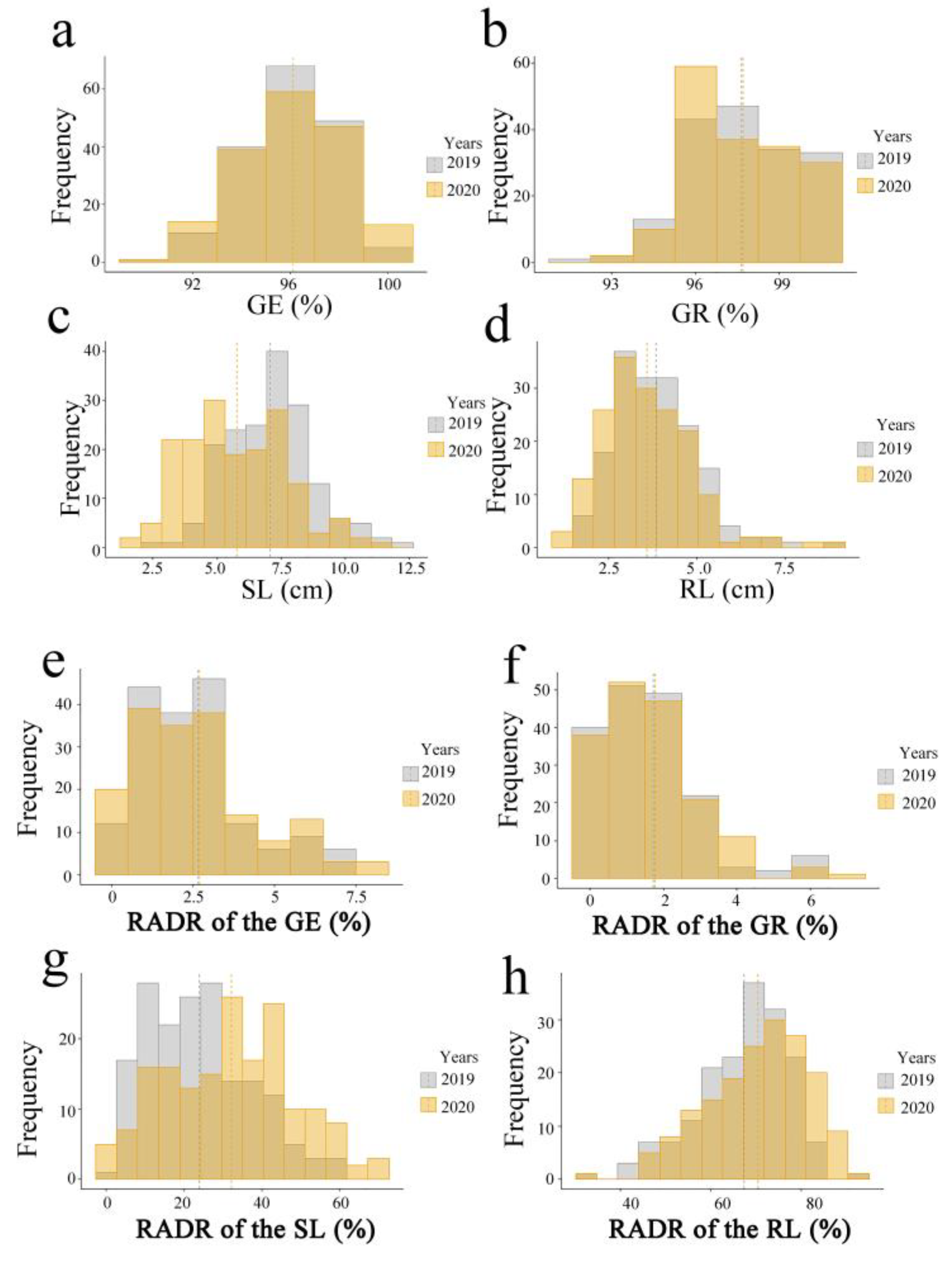

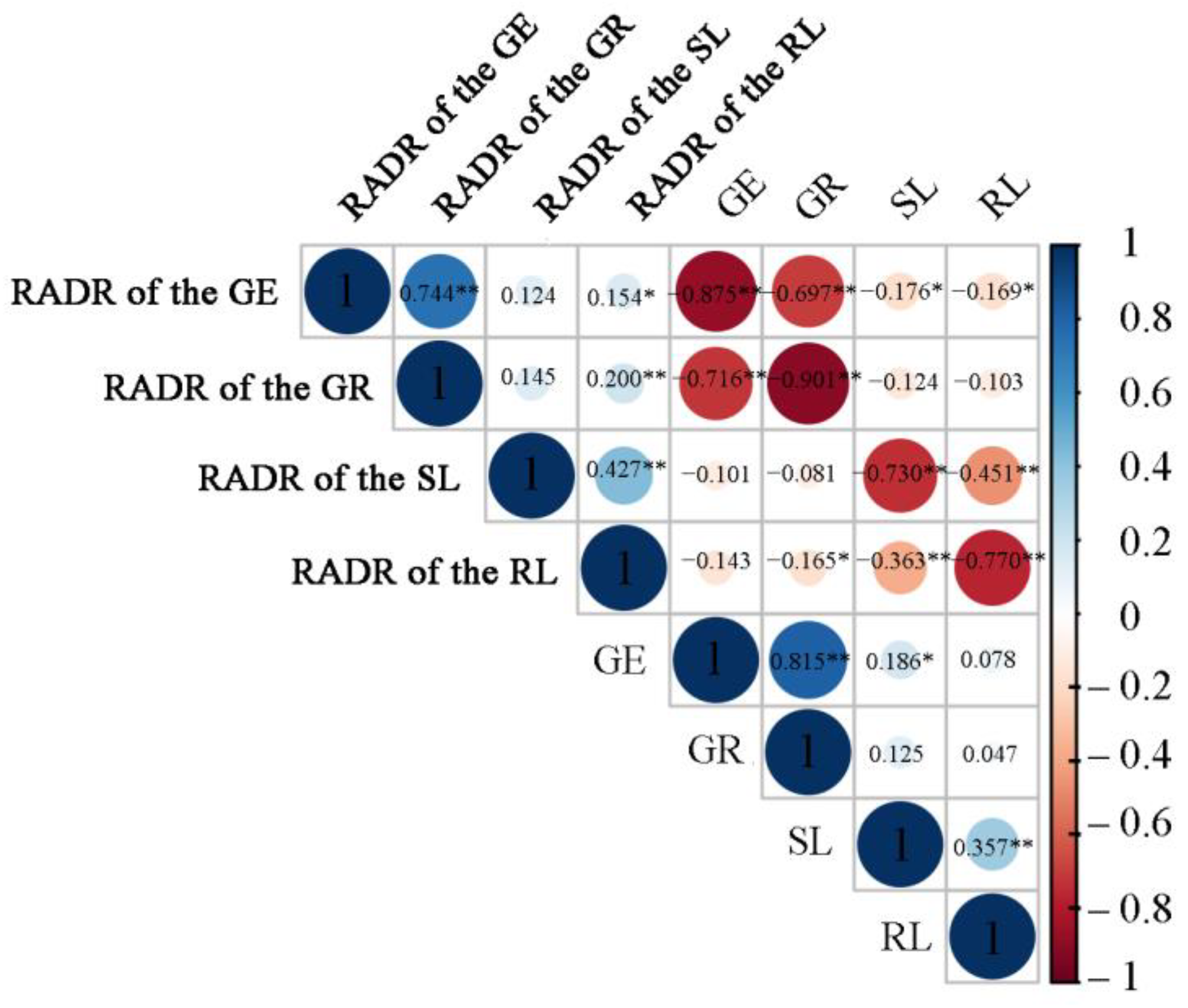
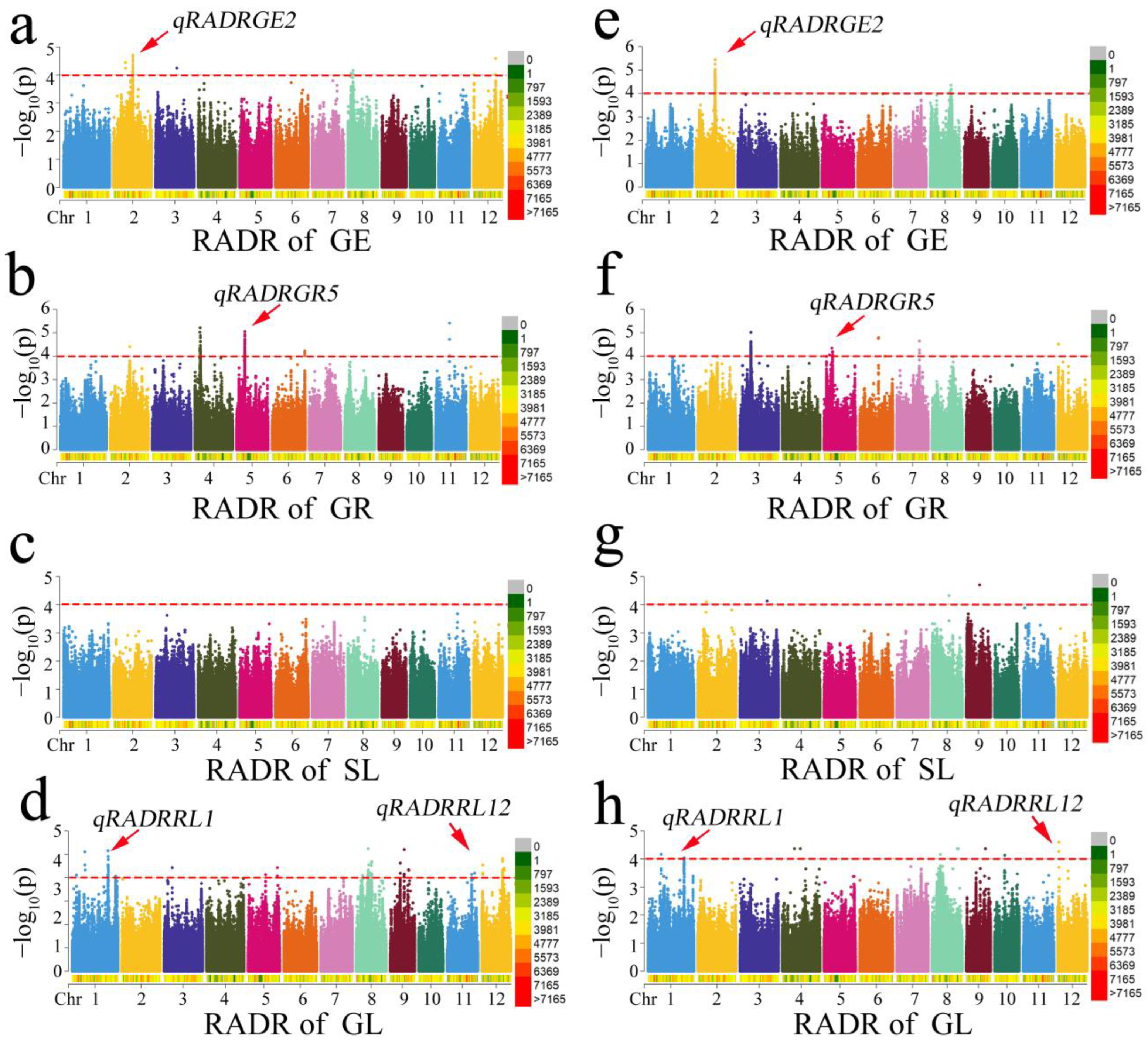
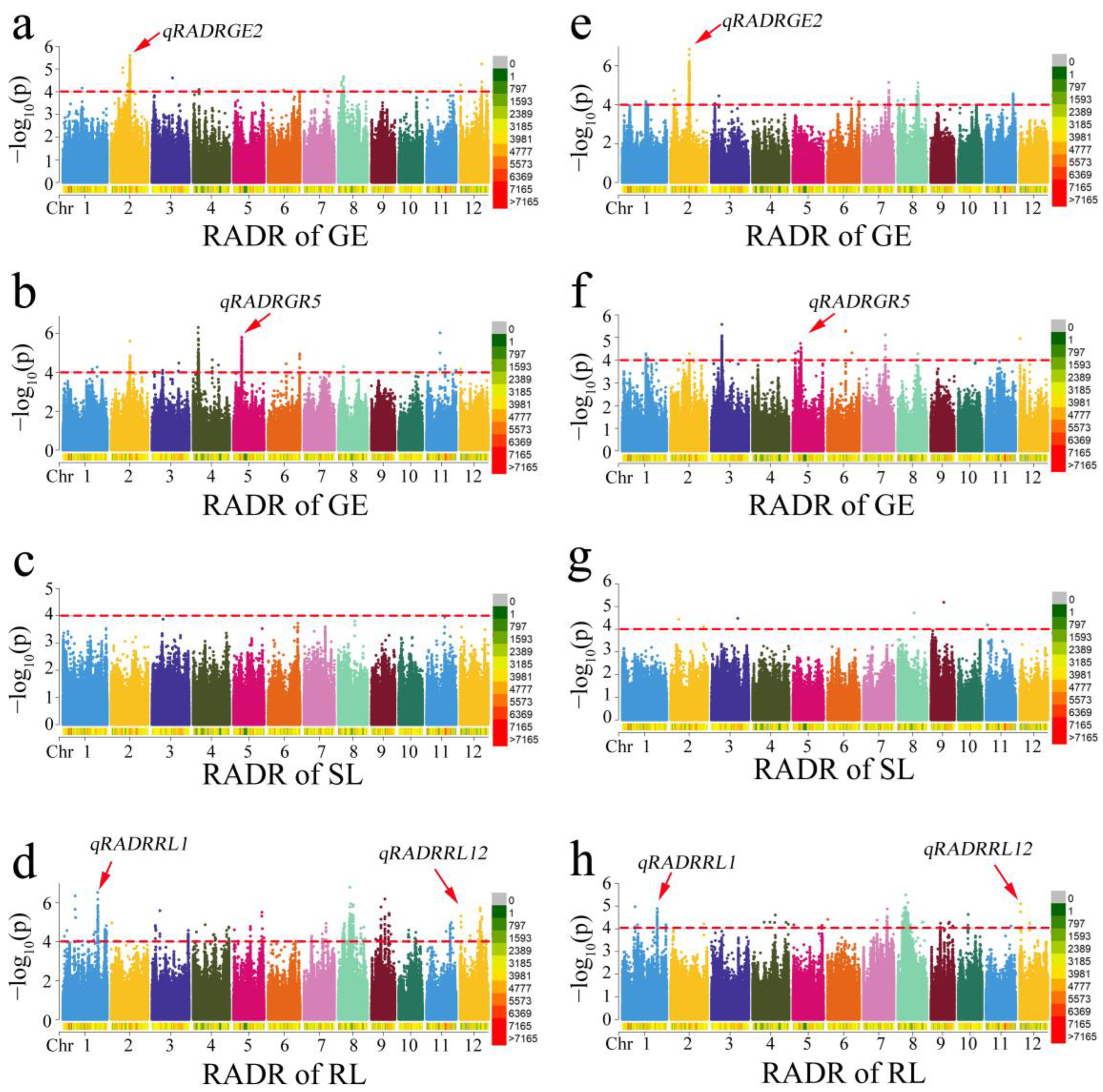
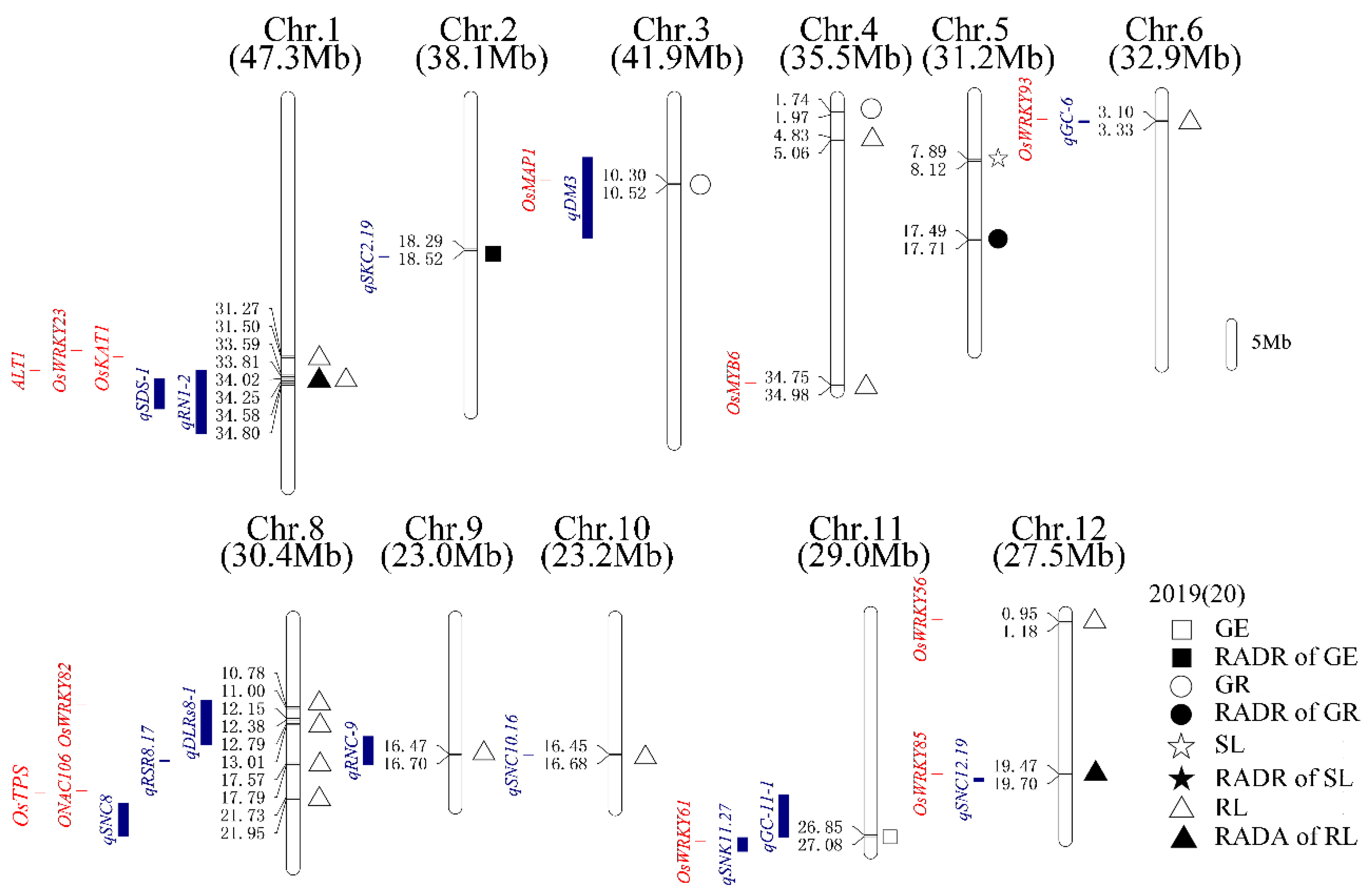
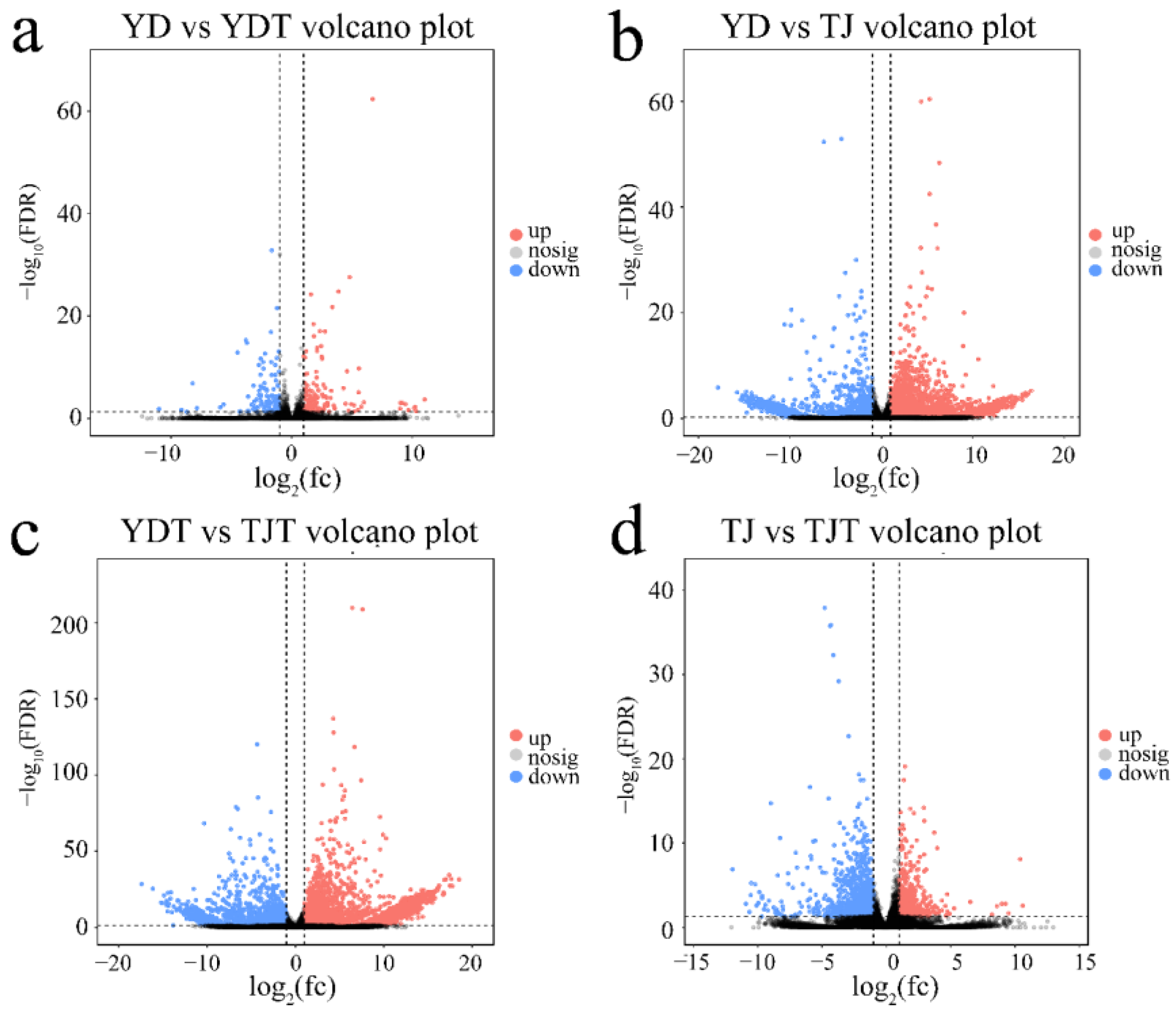
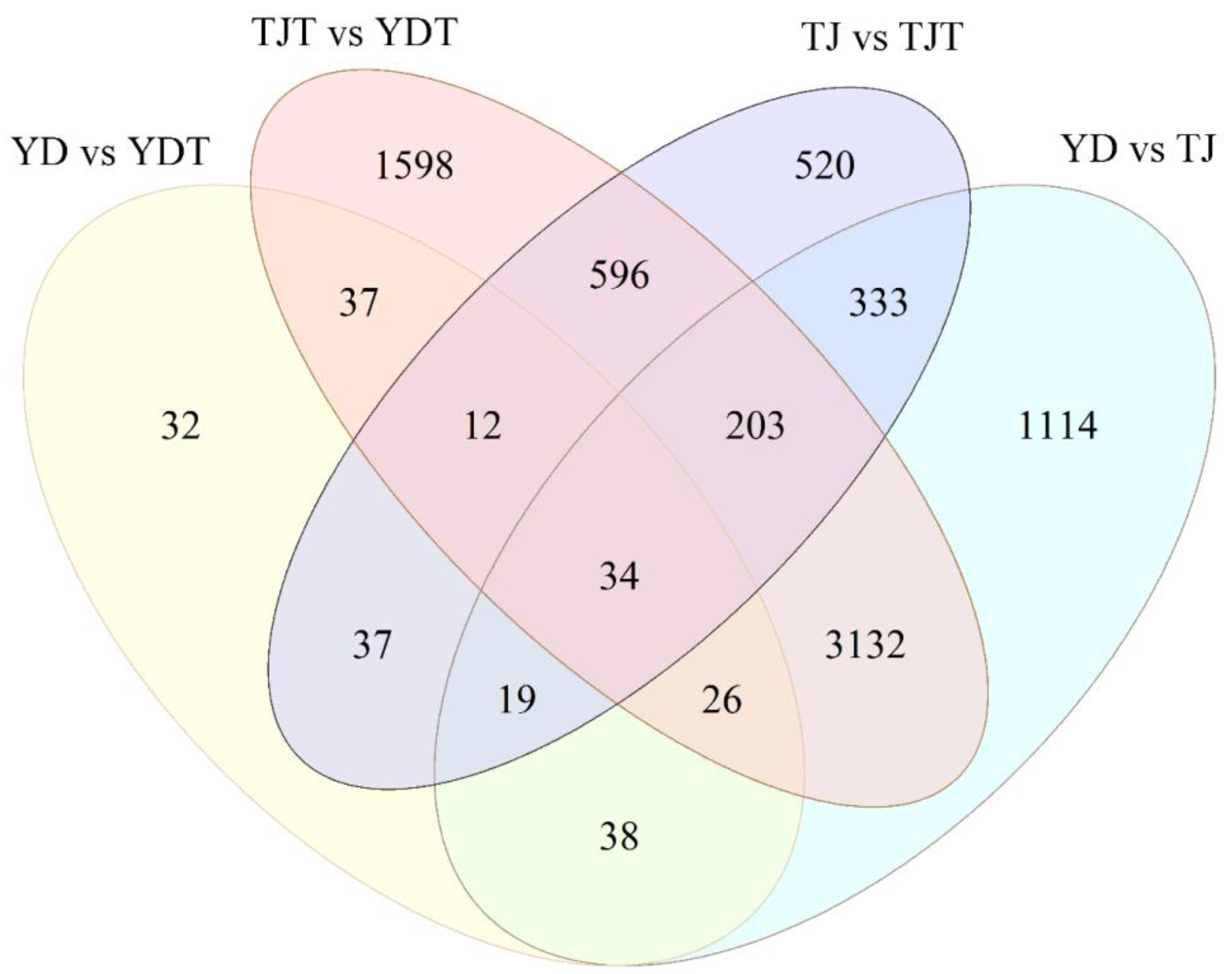
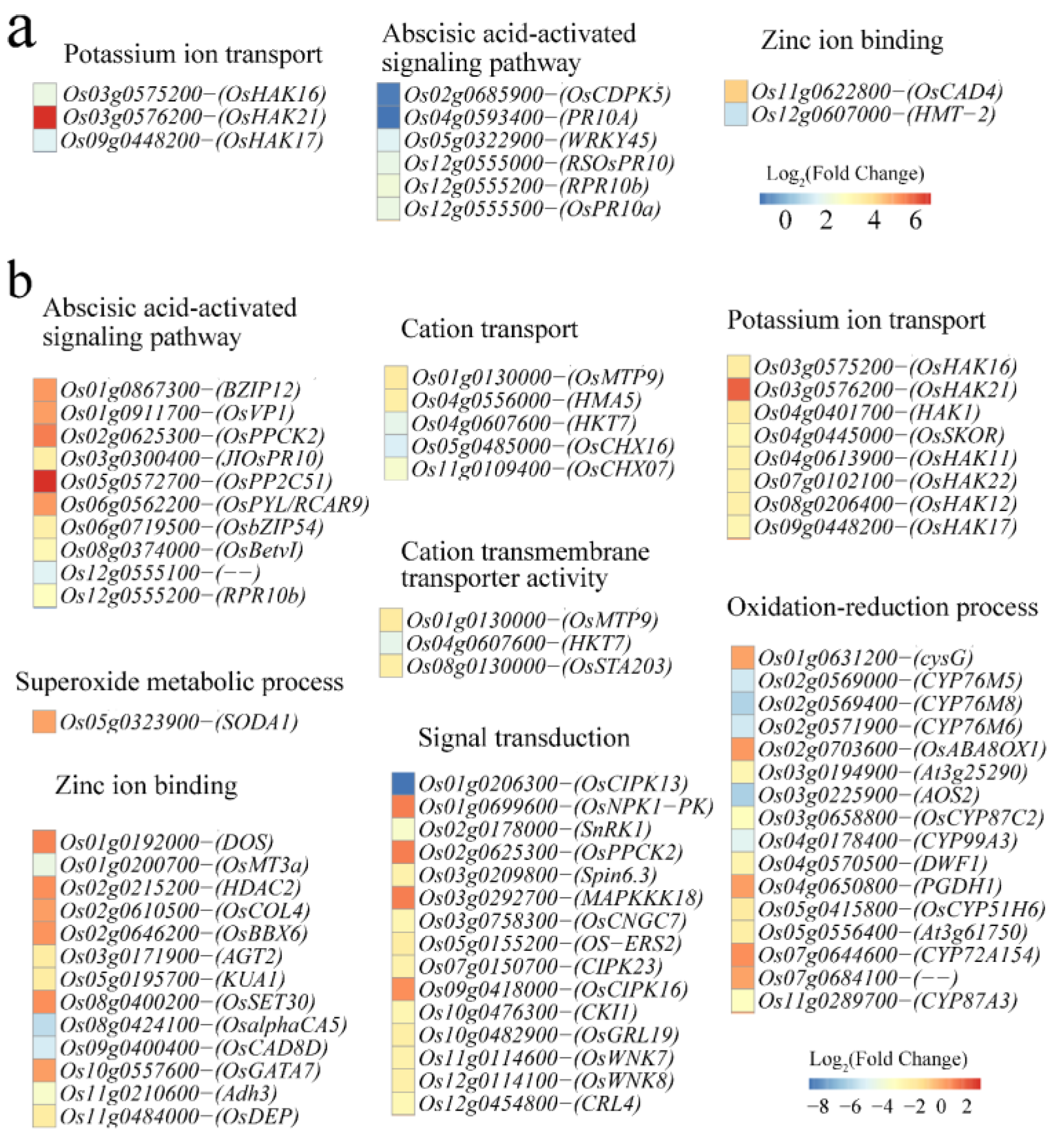




| Phenotype | Year | Mean ± SD | Range | CV (%) | HB2 (%) |
|---|---|---|---|---|---|
| GE (%) | 2019 | 96.12 ± 2.08% | 90–100% | 2.16% | 26.02% |
| 2020 | 96.12 ± 2.28% | 90–100% | 2.38% | 35.55% | |
| GR (%) | 2019 | 97.69 ± 1.76% | 92–100% | 1.82% | 26.65% |
| 2020 | 97.61 ± 1.70% | 93.33–100% | 1.74% | 23.48% | |
| SL (cm) | 2019 | 7.09 ± 1.66 cm | 2.7–11.5 cm | 23.45% | 88.79% |
| 2020 | 5.77 ± 1.97 cm | 1.6–11.1 cm | 34.17% | 96.41% | |
| RL (cm) | 2019 | 3.85 ± 1.18 cm | 1.5–8.9 cm | 30.65% | 68.47% |
| 2020 | 3.57 ± 1.28 cm | 1.4–9.1 cm | 35.75% | 87.73% | |
| RADR of the GE (%) | 2019 | 3.85 ± 1.18% | 0–6.74% | 61.35% | 4.61% |
| 2020 | 2.70 ± 1.84% | 0–7.95% | 67.92% | 11.87% | |
| RADR of the GR (%) | 2019 | 1.71 ± 1.40% | 0–5.56% | 81.83% | 2.05% |
| 2020 | 1.77 ± 1.43% | 0–6.67% | 80.72% | 1.37% | |
| RADR of the SL (%) | 2019 | 23.48 ± 13.22% | 2.98–58.12% | 56.28% | 85.01% |
| 2020 | 32.16 ± 16.36% | 1–70.84% | 50.86% | 91.32% | |
| RADR of the RL (%) | 2019 | 67.07 ± 10.35% | 29.91–90.8% | 15.44% | 81.20% |
| 2020 | 70.51 ± 11.08% | 30.65–90.96% | 15.71% | 89.68% |
| QTL | 2019 | 2020 | ||||||||
|---|---|---|---|---|---|---|---|---|---|---|
| Trait | Chr | Lead SNP | Allele | p-Value | Chr | Lead SNP | Allele | p-Value | Method | |
| qRL8-2 | 8 | 12,263,202 | T/C | 2.32 × 10−10 | 8 | 12,263,202 | T/C | 8.84 × 10−9 | GLM | |
| 8 | 12,263,202 | T/C | 1.01 × 10−5 | 8 | 12,263,202 | T/C | 7.00 × 10−5 | MLM | ||
| qRL8-3 | 8 | 12,906,568 | T/C | 6.94 × 10−11 | 8 | 12,906,568 | T/C | 3.19 × 10−10 | GLM | |
| 8 | 12,906,568 | T/C | 4.92 × 10−6 | 8 | 12,906,568 | T/C | 7.57 × 10−6 | MLM | ||
| qRL8-4 | 8 | 13,496,471 | T/A | 2.22 × 10−11 | 8 | 13,496,471 | T/A | 1.14 × 10−10 | GLM | |
| 8 | 13,496,471 | T/A | 2.35 × 10−6 | 8 | 13,496,471 | T/A | 3.66 × 10−6 | MLM | ||
| qRL8-5 | 8 | 17,677,170 | C/T | 2.81 × 10−11 | 8 | 17,677,170 | C/T | 6.35 × 10−10 | GLM | |
| 8 | 17,677,170 | C/T | 9.24 × 10−7 | 8 | 17,719,736 | T/G | 5.79 × 10−6 | MLM | ||
| qRL8-6 | 8 | 21,842,382 | A/C | 1.87 × 10−11 | 8 | 21,842,382 | A/C | 5.03 × 10−11 | GLM | |
| 8 | 21,842,382 | A/C | 1.09 × 10−6 | 8 | 21,842,382 | A/C | 1.40 × 10−6 | MLM | ||
| qRL9 | 9 | 16,584,303 | C/T | 5.58 × 10−10 | 9 | 16,584,303 | C/T | 1.92 × 10−10 | GLM | |
| 9 | 16,584,303 | C/T | 1.62 × 10−5 | 9 | 16,584,303 | C/T | 4.23 × 10−6 | MLM | ||
| qRL10 | 10 | 16,566,626 | G/A | 1.62 × 10−9 | 10 | 16,566,626 | G/A | 4.54 × 10−8 | GLM | |
| 10 | 16,566626 | G/A | 1.30 × 10−5 | 10 | 16,566,626 | G/A | 6.66 × 10−5 | MLM | ||
| qRL12 | 12 | 19,585,866 | G/A | 2.40 × 10−7 | 12 | 19,585,866 | G/A | 3.07 × 10−6 | GLM | |
| 12 | 19,585,866 | G/A | 1.87 × 10−5 | 12 | 19,585,866 | G/A | 5.66 × 10−5 | MLM | ||
| RADR of the GE | qRADRGE2 | 2 | 18,406,110 | G/A | 2.51 × 10−6 | 2 | 18,406,110 | G/A | 1.30 × 10−6 | GLM |
| 2 | 18,406,110 | G/A | 1.94 × 10−5 | 2 | 18,406,110 | G/A | 1.88 × 10−5 | MLM | ||
| RADR of the GR | qRADRGR5 | 5 | 8,003,569 | T/G | 1.59 × 10−6 | 5 | 8,003,569 | T/G | 2.79 × 10−5 | GLM |
| 5 | 8,003,569 | T/G | 8.89 × 10−6 | 5 | 8,003,569 | T/G | 6.47 × 10−5 | MLM | ||
| RADR of the RL | qRADRRL1 | 1 | 34,136,974 | A/T | 1.35 × 10−6 | 1 | 34,136,974 | A/T | 1.77 × 10−5 | MLM |
| 1 | 34,136,974 | A/T | 1.69 × 10−5 | 1 | 34,136,974 | A/T | 9.05 × 10−5 | GLM | ||
| RADR of the RL | qRADRRL12 | 12 | 1,065,559 | G/T | 4.72 × 10−6 | 12 | 1,065,559 | G/T | 7.99 × 10−6 | GLM |
| 12 | 1,065,559 | G/T | 2.85 × 10−5 | 12 | 1,065,559 | G/T | 2.54 × 10−5 | MLM | ||
Disclaimer/Publisher’s Note: The statements, opinions and data contained in all publications are solely those of the individual author(s) and contributor(s) and not of MDPI and/or the editor(s). MDPI and/or the editor(s) disclaim responsibility for any injury to people or property resulting from any ideas, methods, instructions or products referred to in the content. |
© 2023 by the authors. Licensee MDPI, Basel, Switzerland. This article is an open access article distributed under the terms and conditions of the Creative Commons Attribution (CC BY) license (https://creativecommons.org/licenses/by/4.0/).
Share and Cite
Zhou, Z.; Du, M.; Liu, Z.; Chang, Y.; Xiong, M.; Sun, H.; Cheng, X.; Zhang, Y.; Sun, J.; Wang, R.; et al. SNP Loci and Favorable Haplotype Mining for Alkalinity Tolerance in the Rice Bud Stage. Agronomy 2023, 13, 2954. https://doi.org/10.3390/agronomy13122954
Zhou Z, Du M, Liu Z, Chang Y, Xiong M, Sun H, Cheng X, Zhang Y, Sun J, Wang R, et al. SNP Loci and Favorable Haplotype Mining for Alkalinity Tolerance in the Rice Bud Stage. Agronomy. 2023; 13(12):2954. https://doi.org/10.3390/agronomy13122954
Chicago/Turabian StyleZhou, Zhenzhen, Mingyu Du, Zhengbo Liu, Yingping Chang, Mengyuan Xiong, Hao Sun, Xianping Cheng, Yanan Zhang, Jinghan Sun, Rui Wang, and et al. 2023. "SNP Loci and Favorable Haplotype Mining for Alkalinity Tolerance in the Rice Bud Stage" Agronomy 13, no. 12: 2954. https://doi.org/10.3390/agronomy13122954
APA StyleZhou, Z., Du, M., Liu, Z., Chang, Y., Xiong, M., Sun, H., Cheng, X., Zhang, Y., Sun, J., Wang, R., Zhang, M., Li, X., Li, M., Zhang, C., & Liu, E. (2023). SNP Loci and Favorable Haplotype Mining for Alkalinity Tolerance in the Rice Bud Stage. Agronomy, 13(12), 2954. https://doi.org/10.3390/agronomy13122954






